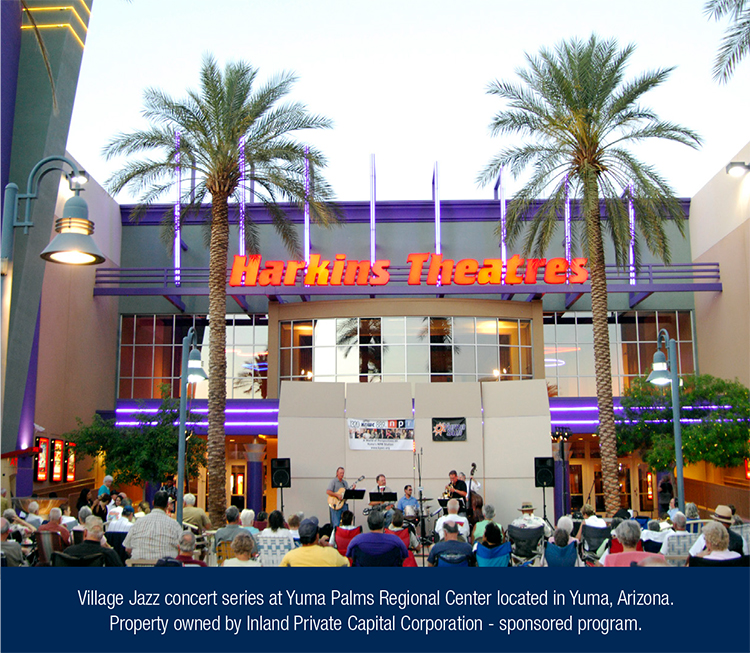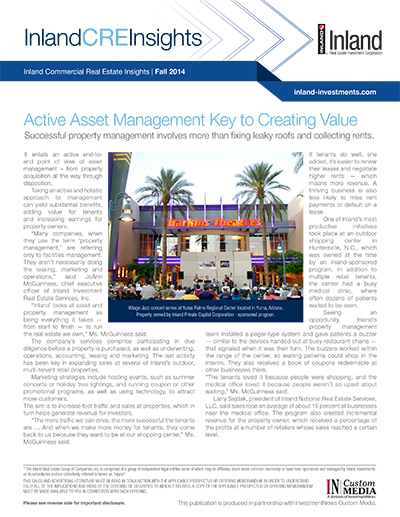Successful property management involves more than fixing leaky roofs and collecting rents.
It entails an active end-to-end point of view of asset management – from property acquisition all the way through disposition.
Taking an active and holistic approach to management can yield substantial benefits, adding value for tenants and increasing earnings for property owners.
“Many companies, when they use the term ‘property management,’ are referring only to facilities management. They aren’t necessarily doing the leasing, marketing and operations,” said JoAnn McGuinness, chief executive officer of Inland Investment Real Estate Services, Inc.
“Inland* looks at asset and property management as being everything it takes — from start to finish — to run the real estate we own,” Ms. McGuinness said.

The company’s services comprise participating in due diligence before a property is purchased, as well as underwriting, operations, accounting, leasing and marketing. The last activity has been key in expanding sales at several of Inland’s outdoor, multi-tenant retail properties.
Marketing strategies include hosting events, such as summer concerts or holiday tree lightings, and running coupon or other promotional programs, as well as using technology, to attract more customers.
The aim is to increase foot traffic and sales at properties, which in turn helps generate revenue for investors.
“The more traffic we can drive, the more successful the tenants are … And when we make more money for tenants, they come back to us because they want to be at our shopping center,” Ms. McGuinness said. If tenants do well, she added, it’s easier to renew their leases and negotiate higher rents — which means more revenue. A thriving business is also less likely to miss rent payments or default on a lease.
One of Inland’s most productive initiatives took place at an outdoor shopping center in Huntersville, N.C., which was owned at the time by an Inland-sponsored program. In addition to multiple retail tenants, the center had a busy medical clinic, where often dozens of patients waited to be seen.
Seeing an opportunity, Inland’s property management team installed a pager-type system and gave patients a buzzer — similar to the devices handed out at busy restaurant chains — that signaled when it was their turn. The buzzers worked within the range of the center, so waiting patients could shop in the interim. They also received a book of coupons redeemable at other businesses there.
“The tenants loved it because people were shopping, and the medical office loved it because people weren’t so upset about waiting,” Ms. McGuinness said.
Larry Sajdak, president of Inland National Real Estate Services, LLC, said sales rose an average of about 15 percent at businesses near the medical office. The program also created incremental revenue for the property owner, which received a percentage of the profits at a number of retailers whose sales reached a certain level.
Inland also has been looking to use technology to create value and drive tenant sales, particularly at shopping centers around colleges, as they tend to draw the most tech-savvy crowds.
In an initiative to spur traffic at a shopping center in Oklahoma City, which was owned at the time by an Inland-sponsored program, Inland partnered with an app provider for a service known as geo-fencing — a location-based mobile service that sets a virtual perimeter and automatically sends notifications of sales to users within a range of that area.

Inland also has been looking to use technology to create value and drive tenant sales, particularly at shopping centers around colleges, as they tend to draw the most tech-savvy crowds.
Inland is also working with a mobile company to provide same-day delivery at one of its shopping centers. Similar to the car service app Uber, the company uses a crowdsourced model that lets users access a network from which they select a driver to deliver items from a store to their home. “These are the creative ideas that we are trying to take and run with,” Sajdak said. “A lot of national retailers are using apps and websites to push notifications and coupons. We’re trying to apply that to local mom-and-pops, which don’t have the resources, experience or expertise.”
Though the trend is toward innovation, tried-and-true concepts can be as effective as cutting-edge ones.
For example, Inland has consistently done well with mail coupons, sending booklets to 12,000 to 15,000 addresses within a given radius of a shopping center.
According to Mr. Sajdak, most businesses consider a 3 to 5 percent coupon redemption rate very good. But Inland reaches between 10 and 15 percent in many cases, and as high as 20 percent in some instances.
Consumers have been shopping in a new way since the recession, he said, adding that landlords and retailers must experiment with different ways to capture business. Playing an active role in all aspects of asset management gives managers the chance to execute effective strategies that can maximize the experience for shoppers, and provide value for tenants and investors.
This sales and advertising literature must be read in conjunction with the applicable prospectus or offering memorandum in order to understand fully all of the implications and risks of the offering of securities to which it relates. A copy of the applicable prospectus or offering memorandum must be made available to you in connection with each offering.
This publication is produced in partnership with InvestmentNews Custom Media.
Disclosure
This is neither an offer to sell nor a solicitation of an offer to buy any security, which can be made only by a prospectus, which has been filed or registered with appropriate state and federal regulatory agencies and sold only by broker dealers authorized to do so. An offering for a real estate investment trust is made only by means of a prospectus in order to understand fully all of the implications and risks of the offering of securities to which it relates. An offer to purchase an interest in a private placement can only be made by a private placement memorandum, and sold only by broker dealers authorized to do so. A copy of a prospectus or private placement memorandum must be made available to you in connection with any offering.
Neither the Securities and Exchange Commission nor any other state securities regulator has approved or disapproved of the securities of any Inland Real Estate Investment Corporation or Inland Private Capital Corporation-sponsored program, or determined if the prospectus for such securities is truthful or complete. Any representation to the contrary is unlawful.
The companies depicted in the photographs herein may have proprietary interests in their trademarks and trade names and nothing herein shall be considered an endorsement, authorization or approval of Inland Real Estate Investment Corporation or its subsidiaries by such companies.
The views expressed herein are subject to change based upon economic, real estate and other market conditions. These views should not be relied upon for investment advice. Any forward-looking statements are based on information currently available to us and are subject to a number of known and unknown risks, uncertainties and factors which may cause actual results, performance or achievements to be materially different from any future results, performance or achievements expressed or implied by these forward-looking statements.
Important Risk Factors to Consider
Some of the risks related to investing in commercial real estate include, but are not limited to: market risks such as local property supply and demand conditions; tenants’ inability to pay rent; tenant turnover; inflation and other increases in operating costs; adverse changes in laws and regulations; relative illiquidity of real estate investments; changing market demographics; acts of God such as earthquakes, floods or other uninsured losses; interest rate fluctuations; and availability of financing.
Some of the risks specifically related to investing in a non-traded real estate investment trust (or “REIT”) include, but are not limited to:
- The board of directors, rather than the trading market, determines the offering price of shares; there is limited liquidity because shares are not bought and sold on an exchange; repurchase programs may be modified or terminated; a typical time horizon for an exit strategy is longer than five years; and there is no guarantee that a liquidity event will occur. Distributions cannot be guaranteed and may be paid from sources other than cash flow from operations, including borrowings and net offering proceeds. Payments of distributions from sources other than cash flow from operations may reduce the amount of capital a REIT ultimately invests in real estate assets and a stockholder’s overall return may be reduced.
- Failure to continue to qualify as a REIT and thus being required to pay federal, state and local taxes, which may reduce the amount of cash available for distributions.
- Principal and interest payments on borrowings will reduce the funds available for other purposes, including distributions to stockholders. In addition, rates on loans can adjust to higher levels, and there is a potential for default on loans.
- Conflicts of interest with, and payments of significant fees to, a business manager, real estate manager or other affiliates.
- Tax implications are different for each stockholder. Stockholders should consult a tax advisor.
The Inland name and logo are registered trademarks being used under license. This material has been distributed by Inland Securities Corporation, dealer manager for the public offering of Inland Real Estate Income Trust, Inc. common stock as well as for programs sponsored by Inland Private Capital Corporation. Inland Securities Corporation, member FINRA/SIPC.
Publication Date: 09.25.14
